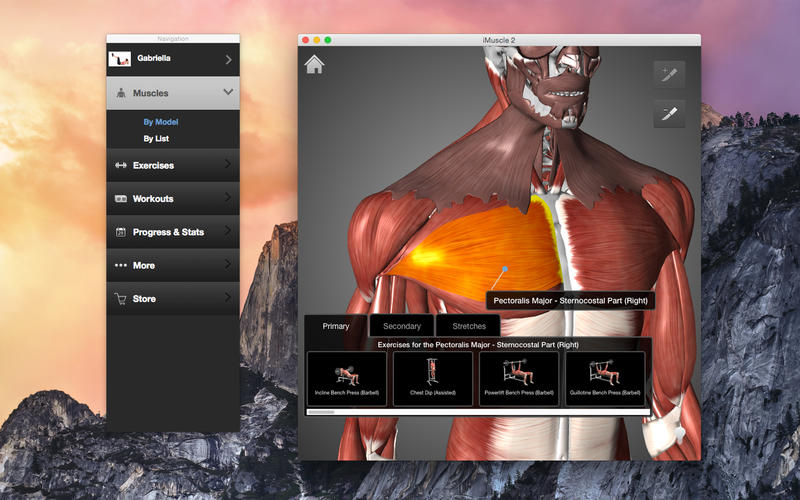

"iMuscle is a sophisticated workout aid."
#Imuscle 2 mac professional#
For personal or professional use, this is a fantastic fitness tool." "iMuscle is a high-quality, professional-grade, but user-friendly app that will help users not just work out, but do so with maximum effectiveness and minimal injury. "Anyone into sports training or rehabilitation science will immediately see the usefulness of this app."

WHAT THE PRESS IS SAYING: "The iMuscle app has the benefit of teaching you more about the muscles that help your body move." Cross platform compatibility is something we will be working towards in the future.
#Imuscle 2 mac android#
It is currently not possible to share workouts or personal data between Android and Apple devices.
#Imuscle 2 mac pro#
NOTE: Not compatible with Macbook Pro (2008) or earlier due to graphics card limitations. Such fibres are found in large numbers in the muscles of the arms.IMUSCLE 2 IS A HIGHLY VISUAL, AWARD WINNING HEALTH AND FITNESS APP THAT HAS EVERYTHING YOU NEED TO PLAN AND TRACK YOUR FITNESS PROGRAM. Type IIB fibers are geared to generate ATP by anaerobic metabolic processes, however, they are not able to supply skeletal muscle fibres continuously with sufficient ATP, and fatigue easily.ĪTP at a fast rate and have a fast contraction velocity.

Type II B fibres are white, while Type I (slow twitch) fibers are red. Type IIB fibres contain a low content of myoglobin, relatively few mitochondria, relatively few blood capillaries and large amounts glycogen. Type IIb fast-twitch fibers, or fast glycolytic fibres (also known as Type IIx), are recruited for very short-duration high-intensity bursts of power such as maximal and near-maximal lifts and short sprints. They have a fast contraction velocity and are more resistant to fatigue than Type IIB. Type IIA fibers have a very high capacity for generating ATP by oxidative metabolic processes, and split ATP at a very rapid rate. Type II A fibers are red, unlike Type II B fibers, which are white. They contain very large amounts of myoglobin, very many mitochondria and very many blood capillaries. Type IIA fibers, or fast oxidative fibers, are used more during sustained power activities such as sprinting 400 meters or doing repeated lifts with a weight below maximum (but not with very light weights). A new study in the February issue of Cell Metabolism suggests that in regards to weight loss, lifting weights may be just as important as running on the treadmill. Furthermore, researchers at Boston University School of Medicine have found that increasing the mass or size of type II muscle fibers will lead to a significant decrease in fat mass or the amount of fat in the body. It is possible that a fiber might be transformed from Type IIB to Type IIAB to Type IIA with exercise training. Type I fibers are characterized by low force/power/speed production and high endurance, Type IIB fibers are characterized by high force/power/speed production and low endurance, while Type IIA fall in between the two. These fast twitch fibers can be further categorized into Type IIa and Type IIb fibers, which are also known as "fast twitch oxidative" and "fast twitch glycolytic," respectively. Muscle fiber types can be broken down into two main types: slow twitch ( Type I) muscle fibers and fast twitch (Type II) muscle fibers. Type II muscle fiber is also known as fast twitch muscle fiber.


 0 kommentar(er)
0 kommentar(er)
